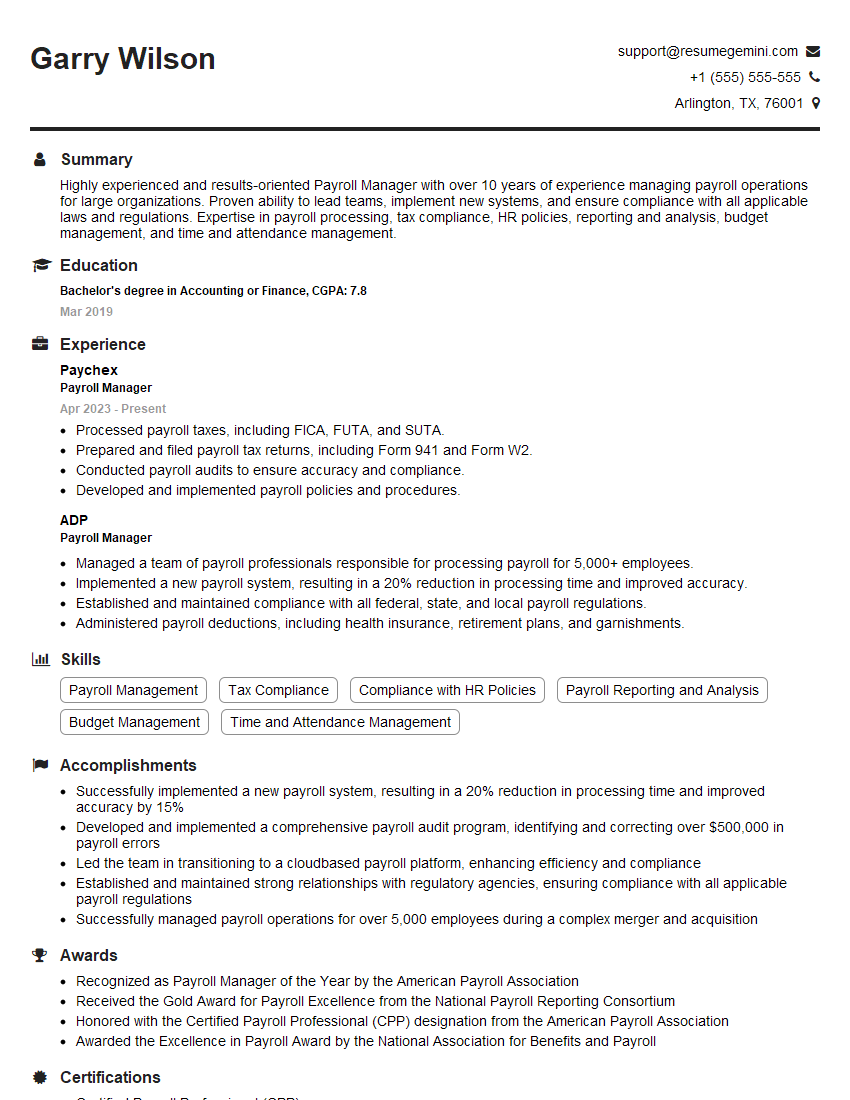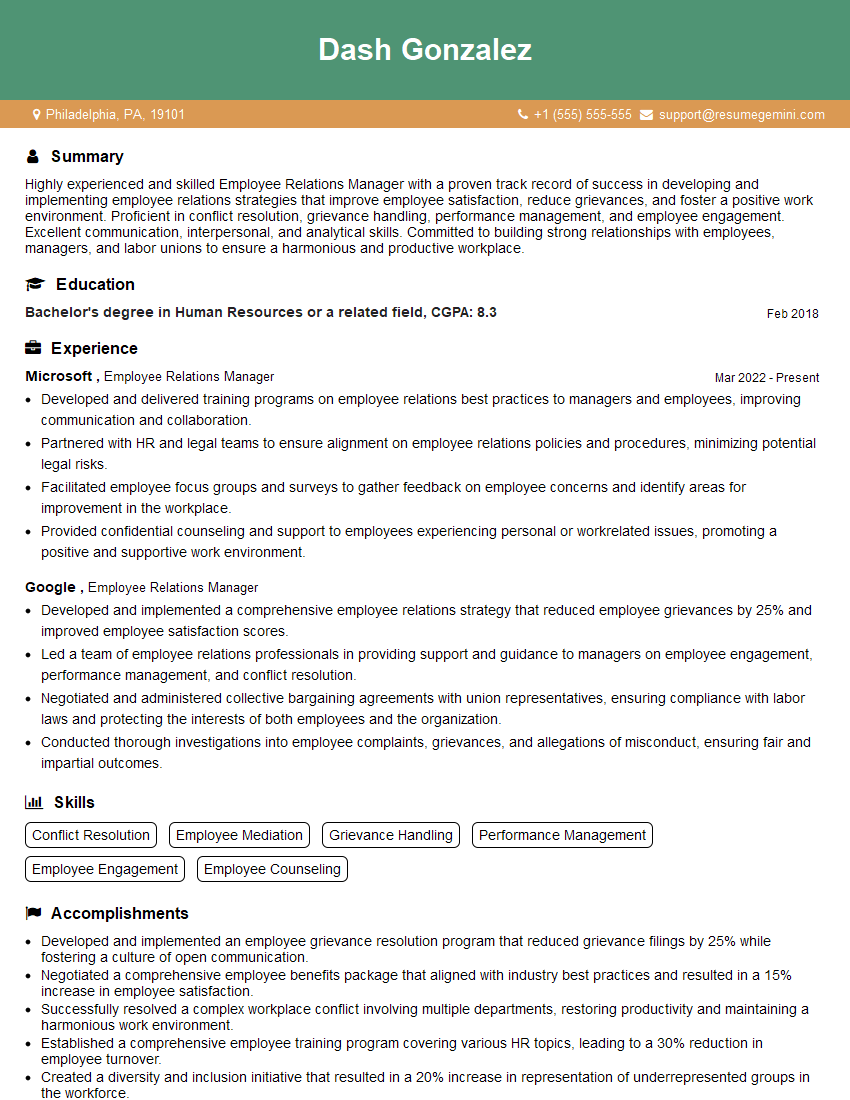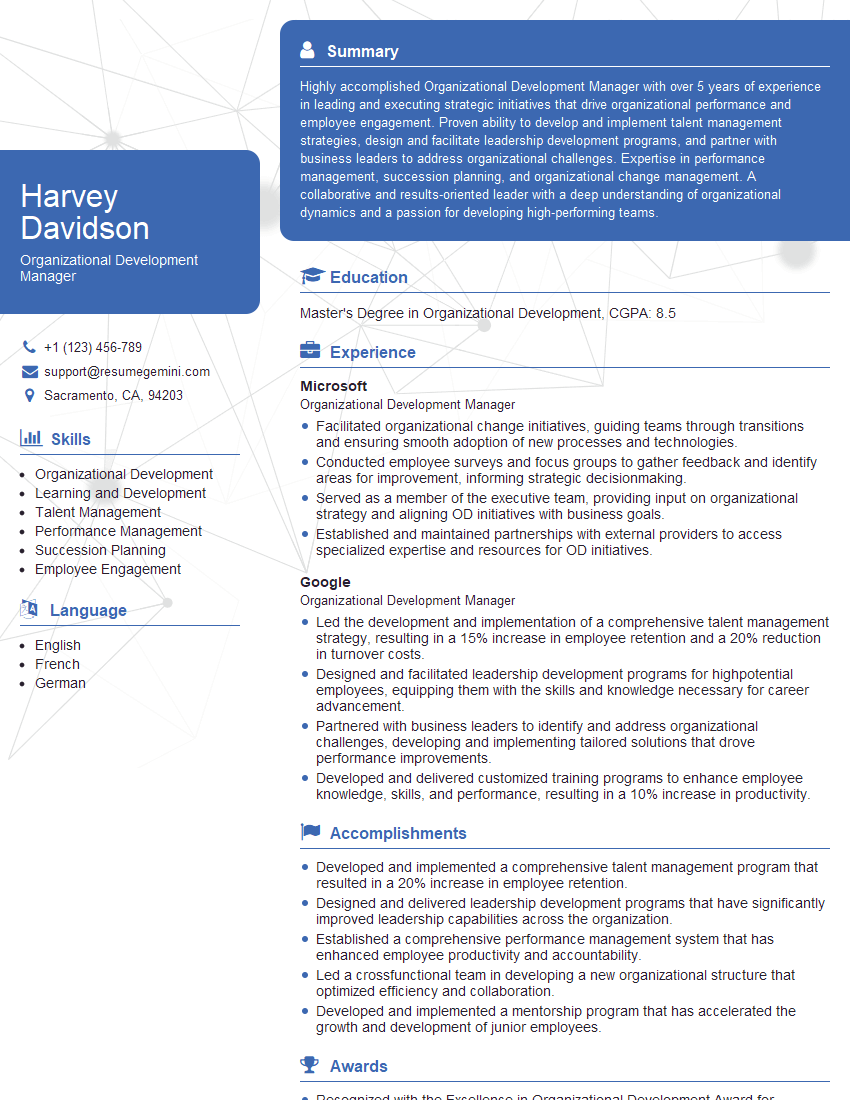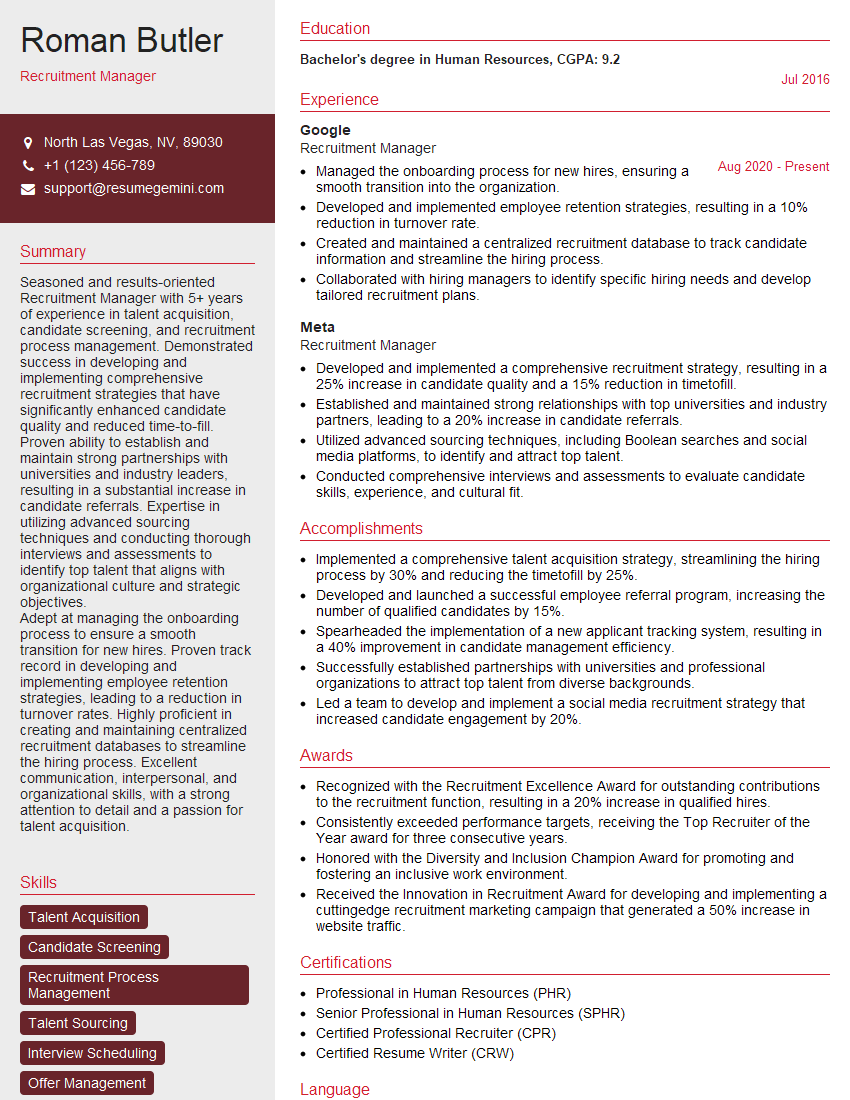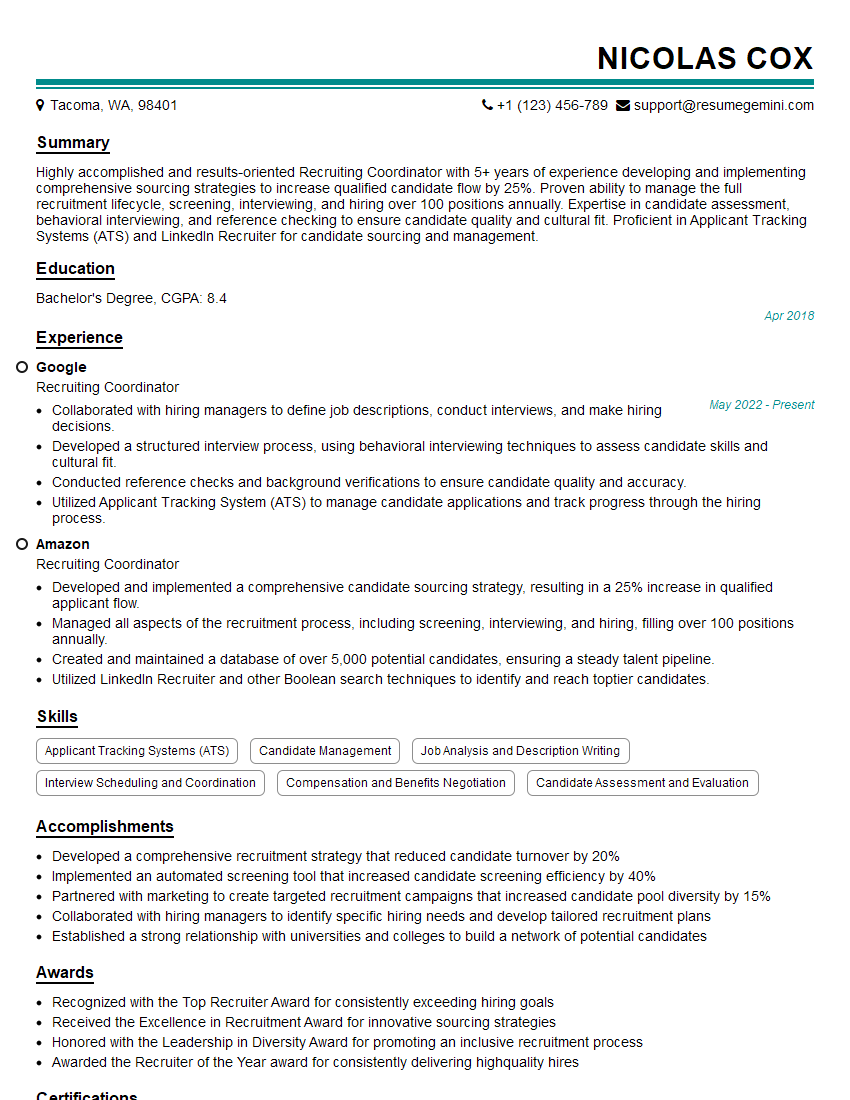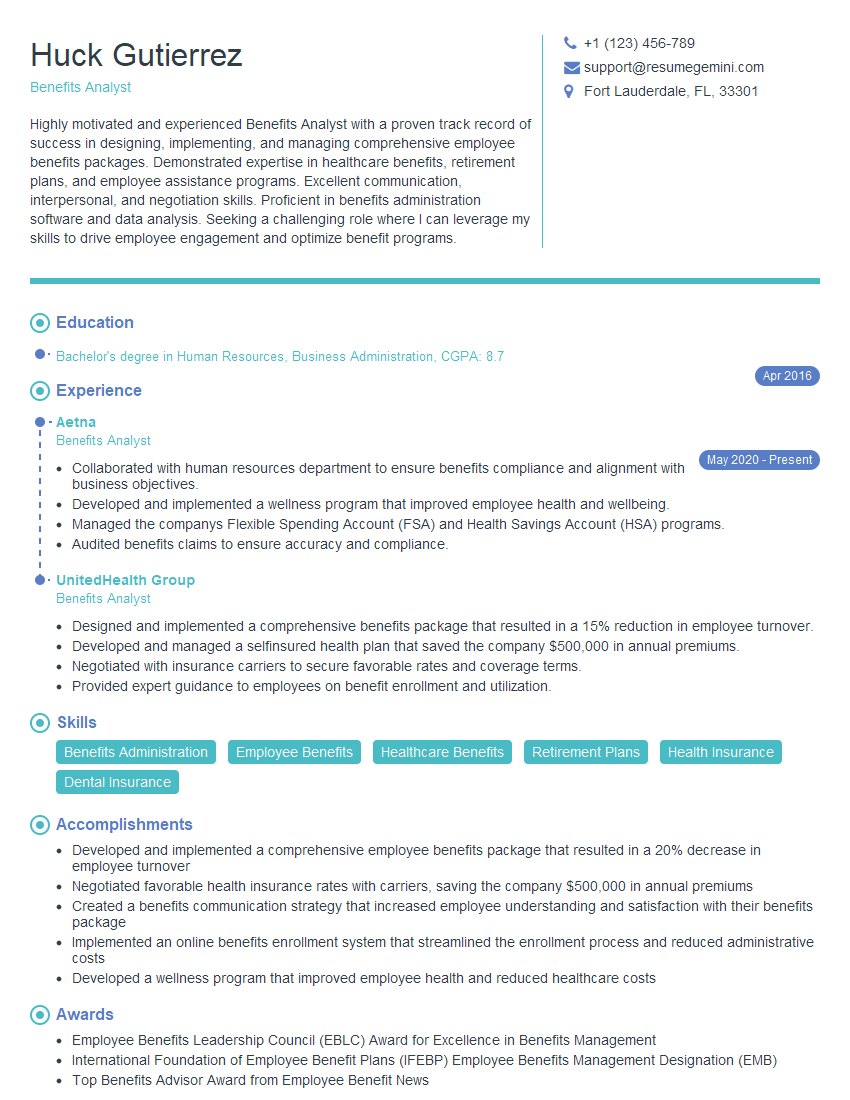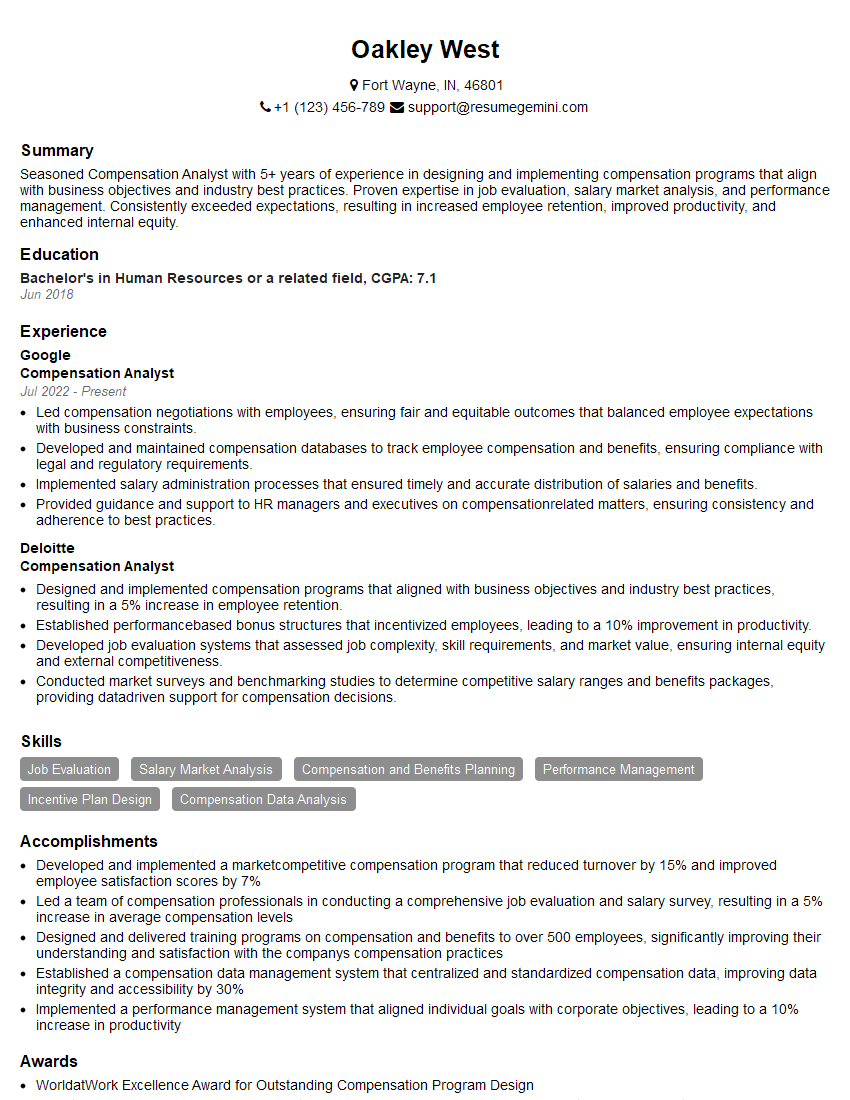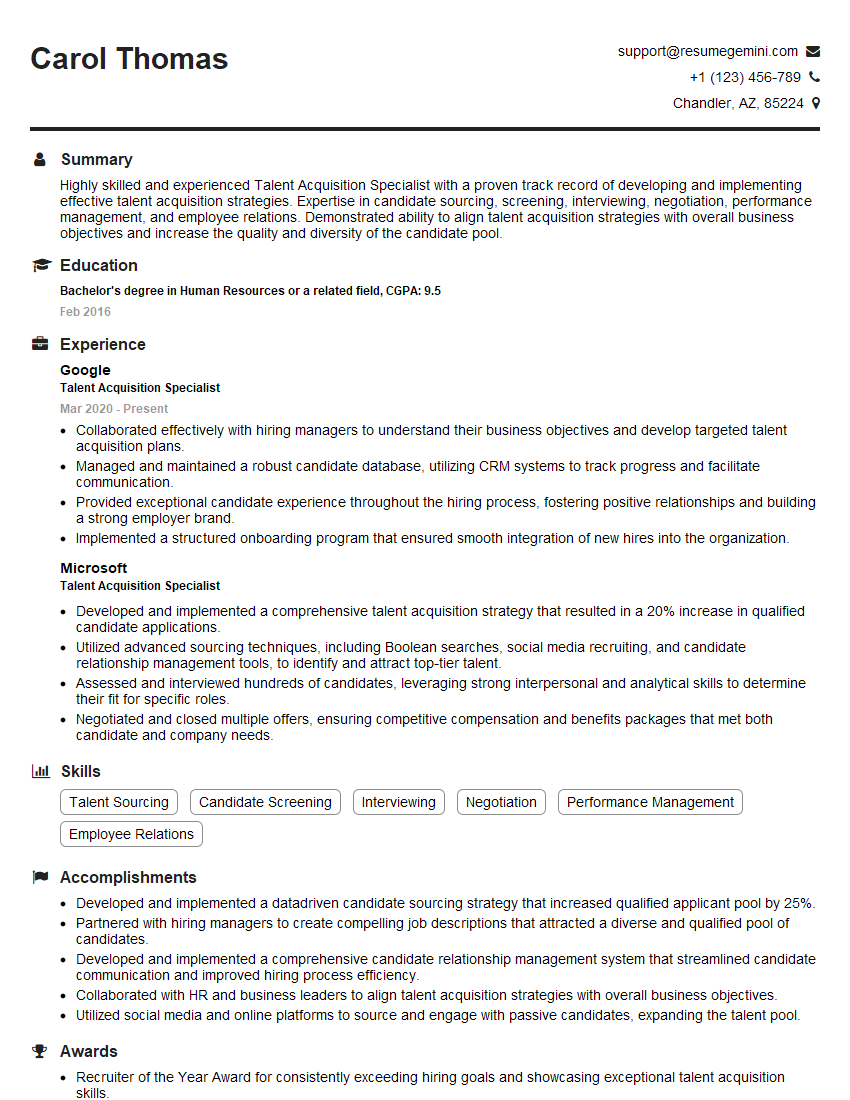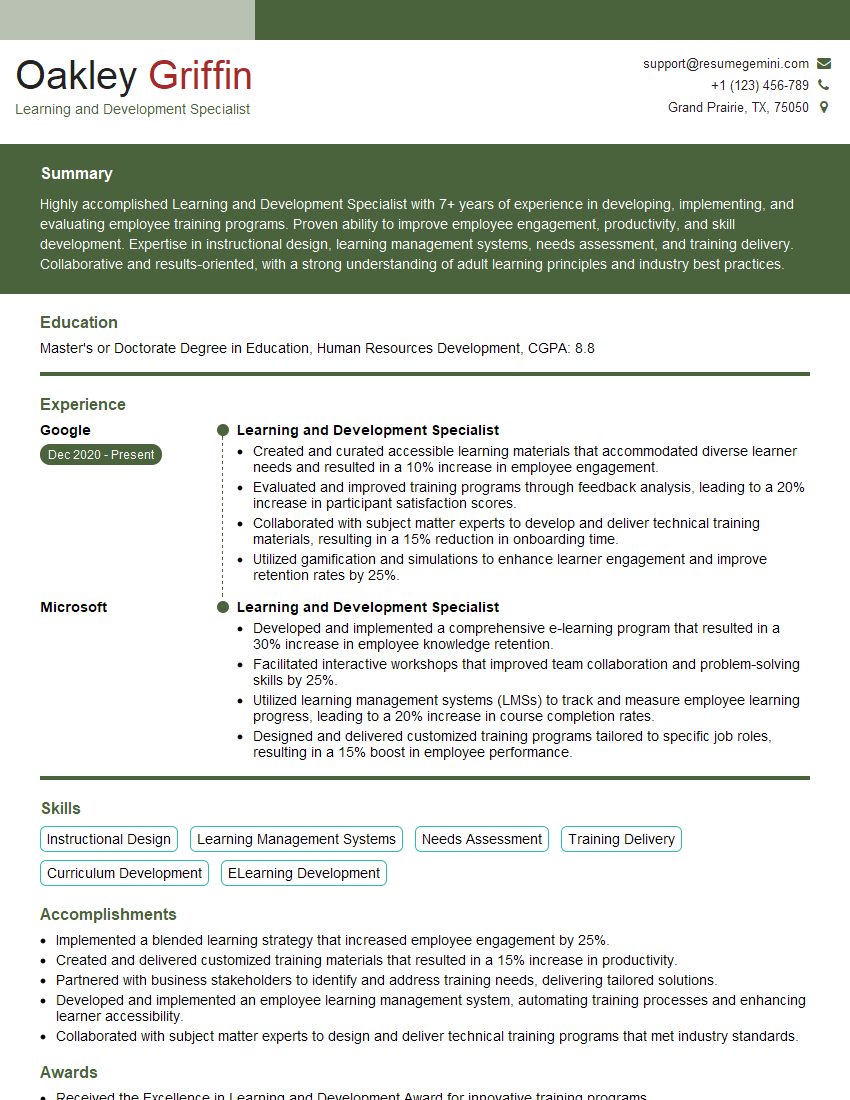The right preparation can turn an interview into an opportunity to showcase your expertise. This guide to Knowledge of Human Resources interview questions is your ultimate resource, providing key insights and tips to help you ace your responses and stand out as a top candidate.
Questions Asked in Knowledge of Human Resources Interview
Q 1. Explain the difference between strategic and operational HR.
Strategic HR and operational HR are two distinct but interconnected facets of human resource management. Think of it like this: strategic HR is the architect designing the overall building (the organization’s workforce strategy), while operational HR is the construction crew building and maintaining it (day-to-day HR tasks).
Strategic HR focuses on long-term goals, aligning the workforce with the organization’s overall business strategy. This includes activities like workforce planning, talent management, succession planning, and organizational development. For example, a strategic HR initiative might involve developing a program to upskill employees in anticipation of future technological changes or creating a diversity and inclusion strategy to attract and retain a wider talent pool. It’s about anticipating future needs and proactively shaping the workforce to meet those challenges.
Operational HR, on the other hand, deals with the day-to-day administration of human resources. This includes tasks like recruitment and selection, payroll processing, benefits administration, employee relations, and compliance with employment laws. For instance, processing employee timesheets, answering employee questions about benefits, or managing the onboarding process for new hires all fall under operational HR. It ensures the smooth and efficient running of the HR department.
While distinct, these two areas are highly interdependent. Effective operational HR supports the achievement of strategic HR goals, and strategic HR provides the context and direction for operational HR activities.
Q 2. Describe your experience with performance management systems.
My experience with performance management systems is extensive. I’ve implemented and managed various systems, from traditional annual reviews to more contemporary, continuous feedback models. In one role, I led the transition from a purely annual performance appraisal system to a more holistic approach incorporating regular check-ins, 360-degree feedback, and goal setting using the Objectives and Key Results (OKR) methodology. This involved not only updating the systems and processes but also providing extensive training to managers on effective feedback delivery and performance coaching.
The key to a successful performance management system is its alignment with organizational goals and its ability to drive performance improvement. A poorly designed system can lead to resentment, demotivation, and legal issues. My focus has always been on creating fair, transparent, and constructive systems that foster open communication and promote employee growth. This includes regular calibration sessions among managers to ensure consistency in evaluations and a robust appeals process for employees who disagree with their performance ratings.
In another instance, I designed a performance improvement plan for an underperforming employee. This involved clearly identifying areas needing improvement, establishing achievable goals with timelines, and providing ongoing support and mentorship. This structured approach led to a significant improvement in the employee’s performance and ultimately contributed to their retention.
Q 3. How do you handle employee grievances and disciplinary actions?
Handling employee grievances and disciplinary actions requires a fair, consistent, and legally compliant approach. My strategy prioritizes proactive conflict resolution and a thorough investigation of all complaints. I believe in creating a culture of open communication where employees feel comfortable raising concerns without fear of reprisal.
When a grievance arises, I follow a structured process. This typically starts with a confidential meeting with the employee to understand their concerns fully. Next, I conduct a thorough investigation, gathering information from all relevant parties and documenting everything meticulously. This may involve reviewing emails, performance records, and conducting interviews. Based on the findings, I determine an appropriate course of action, which could range from mediation and informal resolution to formal disciplinary action, depending on the severity of the situation.
Disciplinary actions are always implemented in accordance with company policies and relevant employment legislation. I always ensure that the employee understands the reasons for the action and has the opportunity to respond. I also provide clear expectations for future conduct and any necessary support for improvement.
Documentation is crucial at every stage. Maintaining detailed records protects the company from potential legal challenges and ensures that the process is fair and transparent. Ultimately, the goal is to resolve conflicts constructively, maintain a positive work environment, and ensure compliance with legal regulations.
Q 4. What are your strategies for improving employee retention?
Improving employee retention requires a multi-faceted approach that addresses both individual and organizational factors. It’s not enough to simply offer competitive salaries; you must create a compelling employee experience.
My strategies focus on several key areas:
- Competitive Compensation and Benefits: Offering market-competitive salaries, comprehensive benefits packages, and opportunities for financial growth is foundational.
- Career Development Opportunities: Providing opportunities for skill enhancement, promotions, and career advancement keeps employees engaged and motivated. This includes mentorship programs, tuition reimbursement, and internal mobility initiatives.
- Recognition and Reward Programs: Regularly acknowledging and rewarding employee contributions boosts morale and reinforces positive behaviors. This could include employee-of-the-month awards, performance bonuses, and public acknowledgement of achievements.
- Positive Work Environment: Fostering a culture of respect, collaboration, and open communication is crucial. This includes promoting teamwork, addressing workplace conflicts promptly, and providing opportunities for social interaction.
- Work-Life Balance: Offering flexible work arrangements, generous paid time off, and promoting a healthy work-life balance helps employees feel valued and reduces burnout.
- Regular Feedback and Performance Reviews: Providing constructive feedback and regular performance reviews helps employees understand their progress and areas for improvement.
By focusing on these aspects, I’ve helped organizations reduce employee turnover significantly. For example, in my previous role, we implemented a comprehensive employee engagement survey which identified a lack of career development opportunities as a major concern. We subsequently introduced a robust mentorship program, resulting in a 15% reduction in employee turnover within a year.
Q 5. Explain your understanding of HR compliance and relevant legislation.
HR compliance is crucial for any organization to avoid legal issues and maintain a positive reputation. My understanding encompasses various aspects of employment law, including equal opportunities, health and safety, data protection, and wage and hour regulations. I’m familiar with legislation such as the Equal Pay Act, the Americans with Disabilities Act (ADA), the Family and Medical Leave Act (FMLA), and the Occupational Safety and Health Act (OSHA) [Note: Specific legislation will vary by country/region].
My approach to compliance involves several key steps:
- Staying Updated on Legislation: I regularly review changes in employment law and best practices to ensure our policies and procedures remain current.
- Developing and Implementing Policies: I work with legal counsel to create comprehensive HR policies and ensure that they align with relevant legislation.
- Training Employees: Providing training to employees on relevant legal issues and company policies is essential for promoting compliance.
- Regular Audits: Conducting regular audits of HR practices helps identify areas for improvement and prevent potential compliance issues.
- Record Keeping: Maintaining accurate and comprehensive employee records is critical for demonstrating compliance in the event of an audit or legal challenge.
In one instance, I identified a potential compliance issue related to equal pay during an annual compensation review. By proactively addressing the discrepancy, we ensured fairness and avoided potential legal action. Maintaining compliance is not just about avoiding penalties; it’s about creating a fair and equitable workplace for all employees.
Q 6. How do you measure the effectiveness of HR initiatives?
Measuring the effectiveness of HR initiatives is crucial for demonstrating value and making data-driven improvements. Instead of relying solely on anecdotal evidence, I employ a variety of metrics tailored to the specific initiative.
Some key metrics I use include:
- Employee Satisfaction: Surveys, feedback sessions, and exit interviews provide valuable insights into employee morale and satisfaction.
- Employee Turnover: Tracking turnover rates helps assess the effectiveness of retention initiatives.
- Time-to-Hire: This metric measures the efficiency of the recruitment process.
- Recruitment Cost per Hire: This helps assess the cost-effectiveness of recruiting strategies.
- Training Effectiveness: Pre- and post-training assessments, along with performance evaluations, measure the impact of training programs.
- Employee Engagement: Using engagement surveys and pulse checks helps understand employee motivation and commitment.
- Diversity and Inclusion Metrics: Tracking representation across different demographics helps assess progress towards diversity goals.
By analyzing these metrics, I can identify areas of success and areas needing improvement. For example, if employee satisfaction scores related to work-life balance are low, it indicates a need to review and adjust flexible work policies. Data-driven decision making allows for continuous improvement in our HR practices and enhances their overall effectiveness.
Q 7. Describe your experience with recruitment and selection processes.
My experience with recruitment and selection processes spans various industries and roles. I’ve been involved in everything from sourcing candidates to conducting interviews, to managing the onboarding process. I’m adept at utilizing a variety of recruitment strategies, including online job boards, social media recruitment, networking, and agency partnerships.
My approach emphasizes creating a positive candidate experience while ensuring we attract and select the best talent. I believe in using objective and fair selection criteria, minimizing bias, and ensuring compliance with equal opportunities legislation. My typical process includes:
- Defining Job Requirements: Collaborating with hiring managers to clearly define the role’s responsibilities, skills, and experience requirements.
- Sourcing Candidates: Utilizing various recruitment channels to identify and attract qualified candidates.
- Screening Resumes and Applications: Reviewing applications and conducting initial phone screens to shortlist candidates.
- Conducting Interviews: Employing structured interviews using competency-based questions to assess candidates’ skills and experience. I also often use behavioral interview questions to assess past performance as a predictor of future success.
- Background Checks and References: Verifying qualifications and references to ensure the candidate’s suitability for the role.
- Onboarding: Managing the onboarding process to ensure a smooth transition for new hires.
In one instance, I implemented a new applicant tracking system (ATS) which streamlined the recruitment process, resulting in a faster time-to-hire and reduced recruitment costs. Using data analytics, we were able to identify which sourcing channels were the most effective and optimize our recruitment strategy accordingly.
Q 8. How do you develop and implement training programs?
Developing and implementing effective training programs involves a systematic approach, starting with a thorough needs assessment. This involves identifying skill gaps, performance issues, or new requirements stemming from business changes or technological advancements. For example, if a company is adopting new software, training is crucial for employees to become proficient.
Next, I design the training content. This could involve creating presentations, workshops, online modules, or even on-the-job training, tailoring the method to the specific learning style and needs of the participants. I always strive to make training engaging and interactive, utilizing techniques like role-playing, simulations, and group discussions to enhance knowledge retention.
Implementation involves scheduling the training, ensuring appropriate resources are available (training rooms, materials, technology), and managing participant logistics. Post-training, I follow up with evaluations to measure the program’s effectiveness, using feedback forms, performance reviews, and knowledge tests to identify areas for improvement. For example, we could measure improvements in efficiency or reduction in error rates post-training.
- Needs Assessment: Identify skill gaps and training requirements.
- Design: Create engaging and effective training materials.
- Implementation: Schedule and manage the training process.
- Evaluation: Measure the effectiveness and identify areas for improvement.
Q 9. How do you manage employee compensation and benefits?
Managing employee compensation and benefits requires a strategic approach that aligns with the company’s overall goals and budget. I begin by conducting a thorough market analysis to determine competitive compensation levels for different roles and locations. This ensures that we attract and retain top talent.
Next, I develop a compensation structure that is fair, transparent, and equitable, encompassing base salaries, bonuses, incentives, and benefits. We establish clear criteria for performance evaluations, linking compensation increases to achievements and contributions. The benefits package needs to be comprehensive, encompassing health insurance, retirement plans, paid time off, and potentially other perks depending on the company’s size and resources.
For example, we might offer a flexible benefits program, allowing employees to customize their benefits choices based on their individual needs. Regular review and adjustments are essential to keep our compensation and benefits packages competitive and relevant. Legal compliance, including adherence to minimum wage laws and reporting requirements, is paramount.
Q 10. Explain your understanding of diversity and inclusion initiatives.
Diversity and inclusion (D&I) initiatives are critical for building a workplace where everyone feels valued, respected, and has equal opportunities. My understanding encompasses creating a culture of belonging where differences are celebrated, not just tolerated. This involves fostering a welcoming environment for people from all backgrounds—racial, ethnic, gender, religious, and others.
Implementing effective D&I initiatives requires a multi-faceted strategy. It starts with diverse recruitment practices, ensuring our job postings and recruitment channels reach a wide range of candidates. Inclusive hiring processes that focus on skills and experience rather than relying on biases are essential. Providing diversity and inclusion training to all employees helps to educate them on unconscious biases, microaggressions, and promote inclusive behaviors.
Furthermore, employee resource groups (ERGs) provide a platform for employees from similar backgrounds to connect, share experiences, and contribute to company initiatives. Regularly reviewing D&I policies and practices to ensure they remain current and effective is crucial. Finally, measuring the impact of D&I initiatives through metrics like employee satisfaction surveys and representation data provides insights for ongoing improvement.
Q 11. Describe your experience with employee engagement strategies.
Employee engagement strategies aim to create a work environment where employees feel connected, valued, and motivated. This isn’t just about employee satisfaction; it’s about fostering a sense of purpose and commitment towards the organization’s goals. My experience involves implementing various strategies to boost employee engagement.
One approach is regular feedback and recognition. This includes providing constructive feedback on performance, celebrating achievements, and acknowledging individual and team contributions. Another key element is fostering open communication channels. This could include regular town hall meetings, employee surveys, suggestion boxes, or even informal channels for feedback.
Creating opportunities for growth and development is crucial. Offering training programs, mentorship opportunities, or career development plans allows employees to enhance their skills and advance within the organization. Building a strong team culture through team-building activities, social events, and creating a supportive environment also contributes significantly to higher engagement. Finally, regularly measuring engagement levels through surveys and feedback provides valuable data to adjust strategies and refine approaches.
Q 12. How do you handle conflict resolution within a team?
Conflict resolution requires a neutral and impartial approach, focusing on addressing the root cause of the conflict, not just the symptoms. My approach is to first listen actively to all parties involved, allowing everyone to express their perspectives and concerns without interruption. I aim to create a safe and respectful space for open communication.
Next, I focus on identifying the core issues driving the conflict. Often, underlying issues are the true cause and addressing them directly is crucial. Once the issues are clear, I facilitate a collaborative discussion to explore potential solutions. I encourage parties to brainstorm solutions together, fostering compromise and mutual understanding. The goal is to find a solution that is acceptable to all parties involved, and that addresses the underlying issues causing the conflict.
In instances where a mutually agreeable solution is difficult to reach, I may mediate, acting as a neutral third party to guide the conversation and help parties find common ground. Documentation of the conflict, solutions, and agreements is important for future reference. Follow-up to ensure the agreement is working is essential, and further mediation may be needed in some cases.
Q 13. What is your experience with HR technology and systems?
My experience encompasses a wide range of HR technologies and systems, including Applicant Tracking Systems (ATS), Human Resource Information Systems (HRIS), performance management software, and learning management systems (LMS). I am proficient in using these systems to streamline HR processes, improve efficiency, and make data-driven decisions.
For example, I’ve used Workday to manage employee data, payroll, benefits administration, and recruiting. I’ve also worked with BambooHR for smaller organizations, and SuccessFactors for performance management and learning and development. My experience includes not only using these systems but also implementing, configuring, and integrating them into the organization’s existing infrastructure.
Furthermore, I understand the importance of data security and compliance in using HR technology. I am knowledgeable about data privacy regulations and best practices to ensure sensitive employee data is protected. My skills extend to reporting and analytics, using HR data to identify trends, inform strategic decisions, and demonstrate the impact of HR initiatives.
Q 14. How do you ensure compliance with data privacy regulations?
Ensuring compliance with data privacy regulations, such as GDPR, CCPA, and other relevant laws, is paramount in HR. This requires a proactive and multi-faceted approach. First, we must establish clear policies and procedures that outline how employee data is collected, stored, processed, and protected. These policies must be readily accessible to all employees and regularly reviewed for updates.
Second, we need to implement robust security measures to safeguard employee data. This includes measures like access controls, encryption, data backups, and regular security audits. We must also train employees on data privacy best practices and their responsibilities in handling sensitive information.
Third, we need to conduct regular data privacy impact assessments to identify potential risks and vulnerabilities. This involves reviewing data processing activities and ensuring that they comply with relevant regulations. Transparency is critical; employees must be informed about how their data is being used. Finally, we must establish processes to respond to data breaches and other security incidents. This includes having a plan in place to quickly identify and contain the breach, notify affected individuals, and report the incident to relevant authorities as required.
Q 15. Explain your understanding of talent acquisition best practices.
Talent acquisition best practices encompass a holistic approach to attracting, recruiting, and onboarding top talent. It’s not just about filling roles; it’s about finding individuals who align with the organization’s culture and strategic goals. This involves several key elements:
- Employer Branding: Cultivating a positive and compelling employer brand that attracts candidates proactively. This includes showcasing company culture, values, and employee experiences on platforms like LinkedIn and company websites.
- Strategic Sourcing: Employing various channels like LinkedIn Recruiter, job boards, internal referrals, and networking to identify qualified candidates. Diversifying sourcing strategies is crucial for reaching a wider pool of talent.
- Streamlined Candidate Experience: Providing a positive and efficient experience for all candidates, from initial application to interview stages. This includes timely communication, clear expectations, and respectful interactions, regardless of the outcome.
- Data-Driven Decision Making: Leveraging analytics to track key metrics like time-to-hire, cost-per-hire, and source-of-hire to optimize the recruitment process. This ensures continuous improvement and efficiency.
- Effective Interviewing: Utilizing structured interviews with behavioral questions to assess candidates’ skills, experience, and cultural fit. This moves beyond basic qualifications and delves into how candidates have handled past challenges.
- Onboarding: A comprehensive onboarding program that integrates new hires into the team and company culture efficiently. This program should not only cover administrative tasks but also foster a sense of belonging and provide necessary training.
For example, in my previous role, we implemented a new employer branding campaign focused on employee testimonials and showcasing our commitment to work-life balance. This resulted in a significant increase in high-quality applications and a reduction in time-to-hire.
Career Expert Tips:
- Ace those interviews! Prepare effectively by reviewing the Top 50 Most Common Interview Questions on ResumeGemini.
- Navigate your job search with confidence! Explore a wide range of Career Tips on ResumeGemini. Learn about common challenges and recommendations to overcome them.
- Craft the perfect resume! Master the Art of Resume Writing with ResumeGemini’s guide. Showcase your unique qualifications and achievements effectively.
- Don’t miss out on holiday savings! Build your dream resume with ResumeGemini’s ATS optimized templates.
Q 16. How do you build strong relationships with employees and managers?
Building strong relationships with employees and managers requires consistent effort, open communication, and empathy. It’s about creating a culture of trust and mutual respect.
- Regular Communication: Holding regular one-on-one meetings, team meetings, and town halls to keep everyone informed and engaged. This could include updates on company performance, upcoming changes, and opportunities for feedback.
- Active Listening: Truly listening to employees’ concerns, suggestions, and ideas. Showing genuine interest in their perspectives fosters trust and a sense of value.
- Empathy and Support: Showing understanding and support for employees, especially during challenging times. This might involve offering resources for mental health or providing support during personal emergencies.
- Recognition and Appreciation: Recognizing and appreciating employees’ contributions, both big and small. This could involve formal awards, informal praise, or public acknowledgment of achievements.
- Conflict Resolution: Addressing conflicts promptly and fairly, utilizing mediation or other conflict-resolution techniques when necessary.
- Mentorship and Coaching: Providing opportunities for mentorship and coaching to support professional development and career growth.
For instance, I’ve successfully mentored junior HR professionals, providing guidance and support in their roles, leading to their increased confidence and improved performance. Building these relationships enhanced team cohesion and boosted overall morale.
Q 17. Describe your approach to change management within an organization.
My approach to change management is based on Kotter’s 8-Step Change Model, which emphasizes communication, involvement, and support throughout the process. It’s crucial to understand that change can be disruptive and requires careful planning and execution.
- Create a Sense of Urgency: Clearly communicate the need for change and the potential consequences of inaction.
- Build a Guiding Coalition: Assemble a team of influential leaders to champion the change initiative.
- Form a Strategic Vision and Initiatives: Develop a clear vision for the future state and define specific, measurable, achievable, relevant, and time-bound (SMART) goals.
- Enlist a Volunteer Army: Get buy-in from employees by actively involving them in the change process.
- Enable Action by Removing Barriers: Identify and remove obstacles that could hinder the change initiative.
- Generate Short-Term Wins: Celebrate early successes to maintain momentum and boost morale.
- Sustain Acceleration: Continuously reinforce the change and address setbacks proactively.
- Institute Change: Embed the changes into the organization’s culture and processes.
For example, during a recent organizational restructuring, I used this model to successfully manage the transition. This involved clear communication, employee involvement, and early wins to maintain positive momentum. The process resulted in increased efficiency and employee engagement.
Q 18. How do you measure employee satisfaction and morale?
Measuring employee satisfaction and morale requires a multi-faceted approach, combining quantitative and qualitative data. This offers a holistic understanding of the employee experience.
- Employee Surveys: Conducting regular anonymous surveys to gather feedback on various aspects of the workplace, such as job satisfaction, work-life balance, and management effectiveness. Tools like SurveyMonkey or Qualtrics can be used.
- Focus Groups: Facilitating group discussions to explore specific issues in more depth and gain richer insights.
- One-on-One Meetings: Regular check-ins with employees to address individual concerns and gather feedback informally.
- Exit Interviews: Conducting exit interviews with departing employees to understand reasons for leaving and identify areas for improvement.
- Pulse Surveys: Short, frequent surveys to track changes in employee sentiment over time.
- Observation: Directly observing employee interactions and behaviors to assess morale and engagement.
- Performance Data: Analyzing productivity, absenteeism, and turnover rates to identify potential issues.
For instance, I implemented a regular pulse survey to track employee satisfaction with our new flexible work policy. This provided immediate feedback, enabling us to make adjustments and ensure the policy remained effective and positively received.
Q 19. What is your experience with onboarding new employees?
My experience with onboarding new employees emphasizes creating a structured and supportive process that integrates new hires quickly and effectively. It goes beyond administrative tasks and focuses on cultural immersion and setting employees up for success.
- Pre-boarding: Communicating with new hires before their start date, providing necessary information and setting expectations.
- Orientation: A comprehensive orientation program that covers company policies, procedures, and culture.
- Buddy System: Pairing new hires with experienced employees to provide mentorship and support.
- Training: Providing job-specific training and development opportunities to enhance skills and knowledge.
- Regular Check-ins: Conducting regular check-ins with new hires to address concerns and provide feedback.
- Feedback Mechanisms: Establishing mechanisms for new hires to provide feedback on their onboarding experience.
In a previous role, I redesigned our onboarding program, focusing on early integration with the team and incorporating more interactive training. This resulted in a significant improvement in new hire retention and quicker time to productivity.
Q 20. How do you conduct performance appraisals and provide feedback?
Conducting performance appraisals and providing feedback should be a collaborative process focused on growth and development, rather than just evaluation. I utilize a combination of methods:
- Goal Setting: Collaboratively setting SMART goals at the beginning of the review period.
- Performance Documentation: Maintaining a record of employee performance throughout the review period, using examples to support evaluations.
- 360-Degree Feedback: Gathering feedback from peers, supervisors, and subordinates to obtain a comprehensive perspective.
- Self-Assessment: Encouraging employees to conduct self-assessments to reflect on their accomplishments and areas for improvement.
- Constructive Feedback: Providing specific, actionable, and constructive feedback, focusing on both strengths and areas for development.
- Goal Setting for Future: Collaboratively setting goals for the next review period, based on feedback and performance.
I find that focusing on specific examples of accomplishments and areas for improvement, rather than general statements, makes the feedback more impactful and actionable. For example, instead of saying ‘improve communication,’ I would say ‘Consider using more concise email communication and actively listening during team meetings to enhance collaboration.’ This provides clear and actionable direction.
Q 21. Explain your experience with succession planning.
Succession planning is a strategic process that identifies and develops high-potential employees to fill critical roles within the organization. It mitigates the risk of losing key talent and ensures organizational continuity. My experience involves:
- Identifying High-Potential Employees: Utilizing performance reviews, 360-degree feedback, and talent assessments to identify employees with high potential.
- Developing Talent Pipelines: Creating talent pipelines for critical roles by tracking the progress of high-potential employees.
- Providing Development Opportunities: Offering development opportunities such as mentoring, coaching, training, and stretch assignments to prepare employees for future roles.
- Creating Development Plans: Creating individualized development plans for high-potential employees to address specific skill gaps.
- Regular Reviews: Regularly reviewing the succession plan to ensure it remains relevant and aligned with organizational goals.
- Contingency Planning: Developing contingency plans to address unexpected departures or changes in organizational needs.
In a past role, I led the development of a succession plan for senior management. This involved identifying high-potential employees, creating development plans, and implementing a mentorship program to ensure smooth transitions in leadership roles. The plan helped the organization navigate a period of significant leadership changes seamlessly.
Q 22. How do you manage employee absences and leave requests?
Managing employee absences and leave requests requires a structured approach that balances employee needs with operational requirements. It starts with a clear and comprehensive leave policy, readily accessible to all employees. This policy should detail various leave types (sick leave, vacation, bereavement, etc.), eligibility criteria, request procedures, and notification requirements.
I typically utilize an automated absence management system to track requests, ensuring accurate record-keeping and streamlined approvals. This system allows employees to submit requests online, supervisors to approve or deny them, and HR to monitor overall absence trends. For instance, if we notice a spike in sick leave in a particular department, we can investigate potential underlying issues, such as workplace stress or inadequate safety measures.
In cases of unscheduled absences, I would follow a progressive discipline approach, starting with a verbal warning, followed by written warnings, and potentially further action depending on the frequency and severity of the absences and company policy. Open communication with the employee is crucial to understand the reasons behind the absences and offer support if necessary. For example, if an employee is struggling with a personal issue affecting their attendance, we might explore options like flexible work arrangements or referral to employee assistance programs.
Q 23. Describe your experience with developing HR policies and procedures.
Developing HR policies and procedures is a critical function, ensuring legal compliance, consistent practices, and a fair work environment. My approach involves a collaborative process, starting with a thorough needs assessment to identify areas requiring updates or new policies. This might involve reviewing existing policies, conducting employee surveys, and consulting with legal counsel to ensure compliance with all relevant employment laws.
Next, I draft the policies and procedures, using clear and concise language that is easily understandable by all employees. I ensure they are aligned with the organization’s overall goals and values. For example, in developing a performance management policy, I would ensure it outlines clear performance expectations, regular performance reviews, processes for addressing underperformance, and opportunities for employee development. After drafting, I would circulate the documents for feedback from relevant stakeholders, including employees and management, before finalizing and implementing the policies.
Finally, effective communication is key. I ensure the policies and procedures are easily accessible to all employees, for example, through an online employee handbook or intranet. Regular training and updates are essential to keep employees informed of any changes or clarifications.
Q 24. How do you ensure a positive and productive work environment?
Creating a positive and productive work environment is a multifaceted task that involves fostering a culture of respect, collaboration, and open communication. This begins with recruitment and onboarding – selecting employees who are a good cultural fit and providing them with a comprehensive onboarding program that helps them integrate seamlessly into the team.
I focus on promoting work-life balance, offering flexible work arrangements where appropriate, and encouraging regular breaks. I also prioritize employee recognition and appreciation, implementing programs to reward and celebrate employee achievements, both big and small. For instance, we might introduce employee-of-the-month awards, team lunches, or informal celebrations to boost morale.
Addressing conflict constructively is also vital. This requires having clear processes for handling grievances, promoting mediation, and providing training to managers on conflict resolution techniques. Regular employee feedback surveys can help identify potential issues early on, allowing for proactive interventions to prevent them from escalating. A strong focus on employee well-being, including mental health initiatives and employee assistance programs, is also crucial for a positive and productive workplace.
Q 25. What is your understanding of employment law?
My understanding of employment law encompasses a broad range of legislation affecting the employer-employee relationship. This includes federal and state laws related to equal employment opportunity, wage and hour regulations (Fair Labor Standards Act – FLSA), workplace safety (Occupational Safety and Health Act – OSHA), employee privacy, and leave entitlements (Family and Medical Leave Act – FMLA).
I am knowledgeable about anti-discrimination laws, including Title VII of the Civil Rights Act, the Age Discrimination in Employment Act (ADEA), and the Americans with Disabilities Act (ADA), ensuring all HR practices adhere to these regulations. This involves understanding protected characteristics, conducting fair and unbiased hiring and promotion practices, and developing policies that prevent harassment and discrimination.
Staying updated on legal changes and best practices is essential. I regularly attend relevant seminars and workshops and consult with legal counsel when needed to ensure compliance and mitigate potential risks. A thorough understanding of employment law is critical to preventing legal disputes and maintaining a lawful and ethical workplace.
Q 26. How do you handle workplace investigations?
Handling workplace investigations requires a systematic and impartial approach. My process begins with a thorough review of the complaint, ensuring all relevant information is gathered. This often involves interviewing witnesses, collecting relevant documents, and reviewing any existing records. Throughout this process, confidentiality is paramount.
I follow a clear investigative protocol, maintaining objectivity and impartiality. This includes interviewing all parties involved, documenting all interviews and findings, and carefully considering all evidence presented. If there are allegations of serious misconduct, I would consult with legal counsel to ensure the process aligns with legal requirements and best practices.
Once the investigation is complete, I prepare a detailed report summarizing the findings and outlining any recommended actions. This might include disciplinary measures, remedial training, or policy changes. I communicate the findings and conclusions to all relevant parties, while adhering to legal requirements regarding confidentiality and privacy.
Q 27. Explain your experience with workforce planning and forecasting.
Workforce planning and forecasting involves strategically anticipating future workforce needs and developing plans to meet those needs. It’s a proactive approach that helps organizations avoid skills shortages and ensure they have the right talent at the right time. My experience includes using various forecasting methods, including statistical modeling, trend analysis, and scenario planning.
For example, I might utilize regression analysis to predict future turnover rates based on historical data. I would also consider factors like business growth plans, technological advancements, and industry trends to anticipate future skill requirements. The output of this analysis informs workforce planning strategies such as recruitment, training, and succession planning.
The process also includes developing talent pipelines and succession plans to ensure that the organization has qualified candidates to fill key positions as they become vacant. This may involve identifying high-potential employees and providing them with opportunities for development and advancement. Regular monitoring and adjustments to the workforce plan are essential to ensure it remains relevant and effective in a dynamic environment.
Q 28. Describe your knowledge of different compensation structures.
My knowledge of compensation structures encompasses various models designed to attract, retain, and motivate employees. These include salary-based compensation, where employees receive a fixed annual or monthly salary; hourly-based compensation, where employees are paid based on the number of hours worked; and commission-based compensation, which ties pay directly to sales performance.
Beyond these basic structures, I’m familiar with more complex models like piece-rate pay (payment based on units produced), bonus structures (based on performance or company achievements), profit sharing, and stock options. Each structure has its advantages and disadvantages, and the most appropriate model depends on the organization’s industry, size, and strategic goals. For instance, a sales-driven company might heavily rely on commission-based pay, while a stable organization may prioritize a salary-based system with performance-based bonuses.
I also understand the importance of conducting regular salary surveys and market analysis to ensure our compensation packages are competitive and equitable. This ensures we attract and retain top talent while remaining fiscally responsible. Furthermore, I’m experienced in developing and administering benefit packages that complement the compensation structure, such as health insurance, retirement plans, paid time off, and other employee perks. A well-structured and competitive compensation and benefits package is essential for attracting and retaining a high-performing workforce.
Key Topics to Learn for Your Knowledge of Human Resources Interview
- Recruitment and Selection: Understand the entire recruitment lifecycle, from job analysis and sourcing to interviewing and onboarding. Consider best practices for diverse and inclusive hiring.
- Compensation and Benefits: Learn about salary structures, benefits packages, and legal compliance related to compensation. Be prepared to discuss strategies for attracting and retaining top talent through competitive compensation and benefits.
- Employee Relations: Familiarize yourself with conflict resolution, performance management, and employee engagement strategies. Understand the importance of fostering a positive work environment.
- HR Technology and Data Analytics: Explore the use of HRIS systems and data analysis to track key metrics, inform decision-making, and improve HR processes. Discuss how data can be used to support strategic HR initiatives.
- HR Laws and Compliance: Gain a solid understanding of relevant employment laws (e.g., equal opportunity, anti-discrimination, workplace safety) and how to ensure compliance within an organization.
- Training and Development: Understand the design and implementation of effective training programs to enhance employee skills and knowledge. Discuss different training methodologies and their effectiveness.
- Performance Management: Learn about different performance appraisal methods, goal setting, and strategies for providing constructive feedback. Discuss how to create a culture of continuous improvement.
- Strategic HR Planning: Understand how HR contributes to the overall strategic goals of an organization. Be prepared to discuss how HR can align its initiatives with business objectives.
Next Steps
Mastering Knowledge of Human Resources is crucial for career advancement, opening doors to leadership roles and impactful contributions within any organization. A strong resume is your first impression – make it count! Create an ATS-friendly resume that highlights your skills and experience effectively. To build a professional resume that truly showcases your qualifications, leverage the power of ResumeGemini. ResumeGemini provides a trusted platform for creating impactful resumes, and we offer examples tailored to showcasing expertise in Human Resources. Take the next step towards your dream HR role today!
Explore more articles
Users Rating of Our Blogs
Share Your Experience
We value your feedback! Please rate our content and share your thoughts (optional).
What Readers Say About Our Blog
Hi, I represent an SEO company that specialises in getting you AI citations and higher rankings on Google. I’d like to offer you a 100% free SEO audit for your website. Would you be interested?
good

